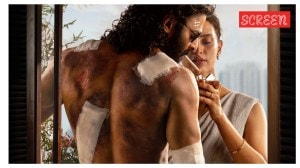When is Art Art?
People frequently ask me where to look for art. They usually want to see paintings made by professional painters. Sculpture is usually off t...

People frequently ask me where to look for art. They usually want to see paintings made by professional painters. Sculpture is usually off the menu and the painter8217;s pre-qualifications, regardless of skills, are a BFA degree or high sales. Except for the increasing numbers of such people and the mushrooming 8216;galleries8217;, very little has changed in the last decade. We obediently think as we8217;ve been trained to: in boxes, by purveyors of skills, rather than by disseminators of ideas.
These Pavlovian instincts received quite a rap on the knuckles recently in Delhi, in, of all places, the government-owned Ashok Hotel. With white marble and a giant chandelier decor, the hotel would have stood proudly, shoulder to shoulder, with the best hotels of the Soviet Bloc. This was till an exercise in ambience creation here became the smelling salts for a comatose public.
The creation was based on the life of the Buddha, commissioned by the Ministry of Tourism as part of its giant conclave for over 700 of the world8217;s leading Buddhist monks. Executing it was Kaaru, an enterprise comprising designers and artisans.
As yellow and white flags fluttered at the hotel entrance, they offered only a hint of the giant Bastar metal alms bowl on the porch, its size alone rendering it a technical feat. The Buddha had already renounced the wealthy life he was born into. Inside, the familiar story became a spectacle, as emotion-charged symbols crystallised into tangibles. The Seven Steps of the Buddha drive the point home: footprints carved from hard, dark stone with specially sharpened instruments by a temple carver lay on a red carpet with lamps.
Any other venue, and it would be more haughty than sacred. Here, heterogeneous monks paid obeisance. On the walls, giant tissue scrolls flowed down like waterwalls. The Bodhisatva tree stood re-invented through the peepal leaves embroidered on them8212;the accumulated wisdom of the hundreds and thousands of monks since the Buddha himself. Above, a cumulus-nimbus canopy of handmade paper, an allusion to the tree of enlightenment, edged out the electric beams of the chandelier. Further ahead, a prayer paper wheel and peacock feathers served more food for thought.
Let8217;s call this exercise, still on display, a show. By choosing neither to dumb things down nor being instructive, the show developed a porous, permeable surface that allows for spontaneous reactions. The structure of the work, something we might call an installation, is terrifying to most because it mocks their understanding of art. This one, through the absence of a single genius creator, and inclusion of rare giant iron-forging and common skills machine sewing, ensured that the world of ideas stood excavated, goading the viewer to think unfettered, instead of suggesting an avenue of correct interpretation for intellectual elites, closed for trespassing fools.
Aesthetics played its part. Art is popularly constructed as an activity whose end is visually likable. By working this into the 2000 square meter space, Kaaru nourished the umbilical cord with the audience. The show also veered towards being public art, in that a heterogeneous, non-art going populace serendipitously found itself in the midst of it all. Many would be uncomfortable in the hostile space of an art gallery8212;a sanctified white cube cum holy mother cow where they watch you as you watch the display. Here, audiences enjoyed art without being overpowered by it. By unleashing this, an unlikely site and show has posed many questions to contemporary art making in India.
- 01
- 02
- 03
- 04
- 05































